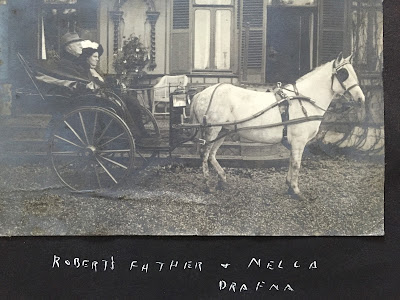 |
| Arms of John Murray, 4th Earl of Dunmore, Governor of the Colony of Virginia. Defeated by the rebels/patriots in 1775. Note stars in two quarters, pierced and unpierced. |
The history of the American Revolution focuses on Yankee fighting at Lexington and Concord–not so much on Virginia.
But the most decisive battle may have been fought 240 years ago today, more than one year before the Declaration of Independence. Two reasons for the importance of the battle:
- The Fight Was Ambiguous. The greatest number of victims in Virginia's skirmishes were slaves seeking their freedom, not free rebels. The British Crown had declared that slaves who joined the army would be emancipated. (The Crown was looking for troops in a hurry and they offered emancipation only to the slaves of rebel slaveholders.)
- The Crown Was Quickly Defeated. The Virginia battles were one-sided. They were over quickly. They were tragic for the slaves who signed up looking for their freedom, most of whom were killed, with few losses on the rebel side. This emboldened the rebels.
In November, Dunmore offered emancipation to any slave of a rebel master willing to join his forces.
- In the short term, it worked well. His emancipation promise attracted many slaves to Gov. Dunmore's army. By November 30, Dunmore’s military ranks had swelled and he was convinced of his ability to regain control of the colony via the promise of emancipation of slaves to rebels. The Continental Army's General George Washington feared Dunmore was correct. He wrote to the Continental Congress from New England, warning that they needed to defeat Dunmore ASAP. Dunmore’s forces won overwhelmingly at Kemp’s Landing. It looked as though Dunmore’s slave troops, which he called the Ethiopian Regiment, would ensure continued British rule in Virginia.
- On the other hand, Dunmore's emancipation promise angered slaveholders on both sides, not just the rebel owners – the slaveholders loyal to the Crown worried about the precedent Gov. Dunmore might set. His promise of emancipation was publicized in the Carolinas and prompted at least 150 men to march north to help defeat Dunmore. Dunmore did not appreciate the number and determination of the Carolina troops and sent only a few sailors and 60 troops from Norfolk to meet them, along with many slave troops. They got within 15 feet of the disciplined and determined rebels before being shot dead. Within 30 minutes, 150 of the Crown troops were killed, with only one rebel fatality.
Of 800 slaves who signed up in anticipation of being freed, only 300 survived the battle. They retreated for safety to the British ship (the Otter), and the majority then contracted smallpox and died from it.
Comment
 |
| Douglas coat of arms (L)–argent azure in chief three stars argent, and Moray (Murray) coat of arms (R)–azure three stars argent two and one. This shield is incorporated in the Murray shield. |
- The high moral ground of the American Revolution – rebellion of colonies against an unjust King – is clouded over with the decimation of the slaves who were seeking only what the rebels wanted, their freedom.
- The Murray family's heroic history in Scotland was that of a leading rebel family. The Scots successfully battled the English Crown under Edward I and Edward II, and negotiated a peace under Edward III. Now the Murrays were defending the Crown against colonial rebels.
This is another piece of evidence that the stars in the Stars and Stripes flag could have originated from the Murray arms, with the blue field from the cross of St. Andrew. The would have been picked up by the Washington family, which lived just south of the border with Scotland, for the coats of arms of George Washington's first knighted ancestor. He used the five-pointed stars but in red, the color of the English St. George cross.
I have corresponded with the Scottish heraldic authorities and they raised the question – why would a sworn enemy mimic an opponent's arms? My thesis is that the Washington family adopted the Murray shield and altered the tincture from blue to red (azure to gules). Yet the United States adopted the East India Company stripes and the Continental Army initially flew stripes with the Union Jack in the canton...




































